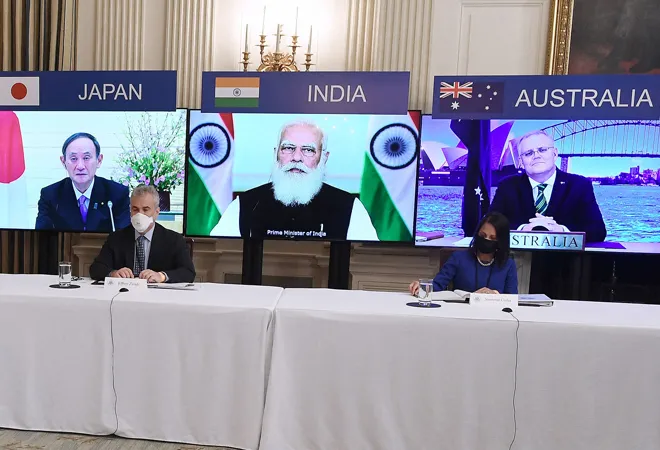 This piece is part of the series, India@75: Aspirations, Ambitions, and Approaches
This piece is part of the series, India@75: Aspirations, Ambitions, and Approaches
The growing importance of the Indian and Pacific oceans have given new momentum to the “Indo-Pacific” as a geostrategic construct. The Indo-Pacific region will shape the trajectory of global politics for most of the 21st century. This is the region where Great Power competition (primarily between the United States (US) and China) is playing out. The region is also home to some of the world’s largest economies. Given China’s questionable policies and expansionist tendencies that are impeding the interests of nearly all in the Indo-Pacific region, and with all major powers like the US, Australia, Japan, United Kingdom (UK), and the European Union (EU) making the Indo-Pacific the pivot of their foreign, defence and security policies, the growing significance of this region is clear. The Indo-Pacific will very much be the fulcrum around which countries will re-orient and re-align their policies.
Japanese Prime Minister Shinzo Abe unveiled the Free and Open Indo-Pacific (FOIP) concept in mid-2016 in Nairobi. Similarly, the US has picked up on the FOIP terminology and even renamed the US Pacific Command as the Indo-Pacific Command. Other countries in the region, including Australia, India, Indonesia and even the Association of Southeast Asian Nations (ASEAN), UK, Germany, Netherlands and now the EU have also adopted some variations of the Indo-Pacific terminology in their foreign policy postures.
India has been active in championing a Free and Open Indo-Pacific. The US, Australia and the members of the ASEAN have all expressed a common view that India should play a greater role in the region. For its part, India regards the Indo-Pacific as a geographic and strategic expanse, with the 10 ASEAN countries connecting the two great oceans. “Inclusiveness, openness, and ASEAN centrality and unity” lie at the heart of India’s conception of the Indo-Pacific. For India, the geography of the Indo-Pacific stretches from the eastern coast of Africa to Oceania (from the shores of Africa to those of the Americas), which also includes the Pacific Island countries. India has been an active participant in mechanisms such as the Indian Ocean Rim Association (IORA), the East Asia Summit, ASEAN Defence Ministers Meeting Plus, ASEAN Regional Forum, the Bay of Bengal Initiative for Multi-Sectoral Technical and Economic Cooperation (BIMSTEC), and Mekong Ganga Economic Corridor, in addition to convening the Indian Ocean Naval Symposium. Through the Forum for India-Pacific Islands Cooperation (FIPIC), India is moving towards engaging with the Pacific Island countries.
India has been active in championing a Free and Open Indo-Pacific. The US, Australia and the members of the ASEAN have all expressed a common view that India should play a greater role in the region.
India’s trade in this region is growing rapidly, with overseas investments being directed towards the East, e.g., the Comprehensive Economic Partnership Agreements with Japan, South Korea, and Singapore, and the Free Trade Agreements with ASEAN and Thailand. India’s approach to the region is exemplified by its evolving “Act East Policy,” comprising economic engagement with Southeast Asia and strategic cooperation beyond that to East Asia (Japan, Republic of Korea), Australia, New Zealand, as well as the Pacific Island countries.
India does not see the Indo-Pacific Region as a strategy or as a club of limited members. Security in the region must be maintained through dialogue, a common rules-based order, freedom of navigation, unimpeded commerce, and settlement of disputes in accordance with international law. India’s view is to work with other like-minded countries in the Indo-Pacific region to cooperatively manage a rules-based multipolar regional order and prevent any single power from dominating the region or its waterways. For instance, while India has always emphasised the need to ensure freedom of navigation and overflight in the SCS, a more vocal stand is now being taken, whereby the SCS has been declared as “the global commons,” wherein all disputes should be settled in accordance with international law and “the interests of no third party should be impinged”. These are subtle messages directed at Beijing. India supports a rules-based, balanced and stable trade environment in the Indo-Pacific region. Sustainable connectivity initiatives promoting mutual benefit should be continually fostered. In this regard, India has been an important stakeholder in the New Development Bank and the Asian Infrastructure Investment Bank. It envisions a central role for multilateral organisations, such as the ASEAN, in managing regional affairs in the Indo-Pacific.
Engaging with its partners in the Indo-Pacific region has become a necessity for India, given the difficult phase in Sino-India relationship, especially after the 2020 Galwan Valley clash. India now believes in issue-based partnerships- this explains India’s embracing of the several minilateral platforms like India-Australia-Japan, India-US-Japan, India-Australia-Indonesia among others which have mushroomed in the Indo-Pacific. Faced with an increasingly powerful and aggressive China, countries such as Australia, Japan, and the US, as well as the ASEAN, are rethinking and remapping their China policies. India, along with its Quad partners, is upping its game in the Indo-Pacific. After the September 2019 Foreign Ministers meeting, the Quad has taken off in a significant way. It is no longer merely a talking shop or just another popular plurilateral platform. In July 2020, the Indian Navy conducted joint naval drills with the US Navy in the Andaman and Nicobar Islands, sending out a clear message to China. India and Australia have signed the Mutual Logistics Sharing Agreement in June 2020; With Japan too India signed the Mutual Logistics Sharing Agreement in September 2020; India and the United States finalised the long-pending Basic Exchange Cooperation Agreement (BECA) in October 2020; India, Australia and Japan have unveiled a supply chain resilience initiative in April 2021 with an aim to counter China’s dominance and with a view to eventually attaining a strong, sustainable, balanced and inclusive growth in the Indo-Pacific. Further, Australia participated in the November 2020 Malabar exercises alongside India, Japan and the United States. India finally came on board with this proposition largely to showcase its commitment to work with like-minded partner countries in the Indo-Pacific and also that India will not shy away from taking tougher decisions and stance if the need arises. This added a military quotient to the Quad, marking the first time since 2007 that all four countries participated in a joint military drill. As the Quad starts to leverage its hard power, and as India’s relations with China deteriorate, New Delhi is likely to reshape its Indo-Pacific strategy alongside its partners. Moreover, given the challenges that the world is grappling with for the ongoing COVID-19 pandemic, it is only logical for India to work with the countries of the Indo-Pacific to build alternate supply chains to reduce its economic dependence on China, to boost its own health infrastructure and R&D, to draw lessons from their response.
India now believes in issue-based partnerships- this explains India’s embracing of the several minilateral platforms like India-Australia-Japan, India-US-Japan, India-Australia-Indonesia among others which have mushroomed in the Indo-Pacific
The Indo-Pacific division in the Ministry of External Affairs (MEA) was set up as a natural corollary to this vision. Since the term “Indo-Pacific” has gained currency and major regional actors such as the US, Japan and Australia are articulating their regional visions (in addition to including this term in their official policy statements), it has become imperative for India to operationalise its Indo-Pacific policy. This MEA wing provides a strategic coherence to the Prime Minister’s Indo-Pacific vision by integrating the IORA, the ASEAN region, and the Quad with the Indo-Pacific dynamic.
It is important that the new MEA division moves beyond security and political issues to articulate a more comprehensive policy towards the region. Commerce and connectivity must be prioritised if India is to take advantage of a new opening for its regional engagement. While India has consistently emphasised “inclusiveness” in the Indo-Pacific framework, it will be challenging to strike a balance between the interests of all stakeholders. While the primary proponents of the Indo-Pacific agree on the values that should be upheld in this region, the approach and policies (Indo-Pacific visions or strategies) vary. For instance, India’s vision is starkly different from the US’. In recent years, India seems to have shed its past caution of standing up to China. However, as geopolitical tensions rise between China and the US, India needs to carefully design its Indo-Pacific architecture while keeping its long-term strategic and economic interests in mind.
The views expressed above belong to the author(s). ORF research and analyses now available on Telegram! Click here to access our curated content — blogs, longforms and interviews.



 This piece is part of the series,
This piece is part of the series,  PREV
PREV


